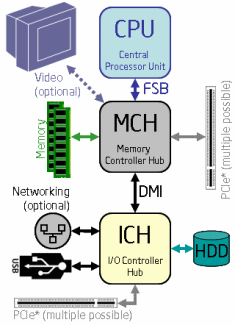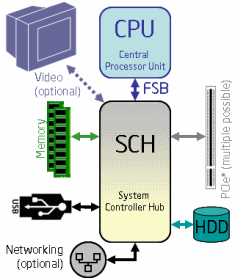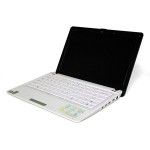 These days, netbooks are the “in” thing. You’ve no doubt seen them around – they’re like little teeny-tiny laptops. Generally speaking, they are slower than a regular laptop, but are smaller and have longer battery lives. For more details, see my post Notebooks, Netbooks, and Hot Air: Laptops Demystified.
These days, netbooks are the “in” thing. You’ve no doubt seen them around – they’re like little teeny-tiny laptops. Generally speaking, they are slower than a regular laptop, but are smaller and have longer battery lives. For more details, see my post Notebooks, Netbooks, and Hot Air: Laptops Demystified.
If you are following the latest netbook craze, you will no doubt be aware that the new Pine Trail platform will be out probably early in 2010 – at least for netbooks. The new dual-core Atoms will most likely be released in Q4 of this year.
I’ve been packing my brain full of all kinds of specs and reviews and datasheets and whatnot, and I’m here to tell you that you can get tomorrow’s netbook platform today – if you know what to look for.
In my recent post on notebooks and netbooks, I wrote the following:
Windows 7 will be released on October 22, 2009. So, if you’re in the market for a netbook, wait until October and get the new Atom platform, longer battery life, more power, a higher res screen, and Windows 7 all in one fell swoop.
I would like to revise my recommendation slightly.
You see, most Netbooks today use the Intel Atom N270 at 1.60 GHz, or the N280 at 1.66 GHz. The N280 was supposed to be accompanied by a “GN40” chipset. Instead, basically all netbooks with the N270 and N280 use Inte’s 945GSE chipset. Note the basic block diagram, as well as the 11.8W system TDP (click image to see specs on Intel.com):
Well, in recent months there have been a few new netbooks that use the Z-series of Intel’s Atom. Most of these netbooks use the Atom Z520 at 1.33 GHz. This slightly slower processor is coupled with the US15W chipset. Note the different block diagram and also the 4.3W system TDP (click image to see specs on Intel.com):
No, you aren’t imagining things: That 4.3W TDP sounds suspiciously like some of the rumors of Intel’s Pine Trail platform (others say Pine Trail will have a 7W TDP), and the US15W chipset looks a bit like Pine Trail’s “one chip + processor” configuration that will allegedly be so much more power-efficient. I don’t think this is a coincidence. In fact, the US15W also just happens to use what appears to be the very same Intel Graphics Media Accelerator 500 (GMA 500) – which is actually a PowerVR SGX graphics core – that is fully capable of handling in hardware any HD video thrown at it.
Of course, Pine Trail will actually have the graphics core and memory controller moved into the processor itself, and the second chip (Tigerpoint) will only be for I/O. Still, the core hardware components are more or less identical to those in a Z5xx + US15W platform from the info we have at this point.
But first, let’s back up a minute and summarize. Current options are the following:
- N270/N280 at 2.5W + 945GSE consisting of 2 chips at 3.3W and 6W = 11.8W system power usage
- Z520/Z530 at 2W + US15W consisting of 1 chip at 2.3W = 4.3W system power usage
Of course, the power figures above are strictly for the Atom + chipset, and ignore any power used by the harddrive, LCD screen, etc. But in terms of the Atom platform itself, we can see that the newer Z5xx + US15W combo reduces power consumption by 63%. That’s a big honkin’ reduction, and is strangely similar to the claimed 66% power reduction predicted for Intel’s Pine Trail platform! And the new Atom N450 processor will run at – you guessed it – 1.66 GHz. It will also support DDR2-667 RAM, whereas the US15W supports only DDR2-533. This difference plus some other architectural differences in Pine Trail might make the new platform a bit zippier than the Z5xx + US15W combo, but don’t count on it being a huge improvement. Intel wants to make the bucks from their CULV processor sales, and they aren’t going to make Pine Trail blazingly fast.
Which brings us to the next point: the allegedly poor performance of Z5xx processors when combined with the US15W that is supposed to do hardware decoding of HD video without flinching. You may be aware – based on mountains of posts on various forums on the net – that end users are finding that their “newer” netbooks with the US15W are not performing up to par. There seems to be a very logical reason for this.
Remember reading Intel’s schtick about how Pine Trail could be used in fanless netbooks? Well, there are already fanless netbooks on the market that use the US15W. Check out Yugatech.com:
Yuga writes:
After trying out the Sony Vaio P, I was curious whether there’s any performance difference between the Intel Atom Z530 and the Atom N270. Both chips run at 1.6GHz so I thought they’d have similar results with Super Pi.
Turns out my assumptions were wrong. Clock for clock, the Atom N270 beats the Z530 in Super Pi by as much as 35%. See chart below for the Super Pi results from 16k to 2M.
To which a readers replies:
The problem when running benchmarks on the Sony VAIO P is it’s passive cooling (no fan for the CPU). When you put some heavy load onto the machine, e.g. running benchmarks over a longer period of time, the CPU Core temperature rises over a critical level (90° C) and the processor begins to throttle. Then it runs only with 800MHz instead of 1600Mhz.
See also page 21 of the Atom Z5xx datasheet:
http://download.intel.com/design/processor/datashts/319535.pdf[…]
I got the same problem when running benchmarks on the VAIO P (SuperPI, CrystalMark09 etc.). Sometimes the results fluctuate more than 10% or more, so i searched for the problem. I observed the CPU-Speed during benchmarks and after some time the CPU throttles to 800MHz.
If you keep this in mind, you get nearly the same results in SuperPI as Atom N270 and N280 CPU. Here are my results: […]
And so, now it all begins to become very clear. Everyone is talking about how even the Atom Z530 at 1.6GHZ is so much slower than the N270 (also at 1.6 GHz). But the problem seems to have nothing to do with the processor architecture itself; the problem is the cooling solution used in the lower-power Z5xx-based netbook systems.
Acer recently released it’s Aspire One 751 netbook with a Z520 at 1.33 GHz, coupled with the US15W chipset. It consistently scores lower in performance benchmarks than, say, an Asus EeePC 1000HE with the N-series Atom. This isn’t terribly surprising, though. The 751 is a seriously thin machine, which means less effective cooling and no overclocking (automatic or manual). The 1000HE, on the other hand, has its “Super Hybrid Engine” (SHE) which allows overclocking the processor to 1.7 GHz. That means Asus has used much better cooling in the 1000HE (which uses the 945GSE at the higher system TDP). SHE also means that when running your 1000HE on battery power, your little Atom is underclocked to 1.2 GHz to save power! When dealing with performance comparisons in netbooks, the devil really is in the details.
Furthermore, Asus will soon release their 1101HA netbook globally. It has a Z520 at 1.33 GHz, the US15W, and a configurable SHE so that if you want, you can overclock the processor (for plugged-in “high performance” mode) to as high as 1.7 GHz. According to NetbookItalia.it, the performance is actually the same or higher than the tested N-series netbooks. Not surprising, really, since they’re basically the same processor!
In the case of the EeePC models that are indeed as fast as the 1101HA, they may in fact have been running SHE (or something similar) and could have been overclocked as well to 1.7 GHz automatically.
In any case, the one thing that makes the overclocked performance in the 1101HA possible is the excellent active cooling. You can see pics of the 1101HA stripped down component by component here: Asus Eee PC 1101HA Seashell netbook dissected. Note the nice big cooling fan.
And yes, overclocking your 1.33 GHz processor to 1.66 GHz will mean the processor uses more power. But since the Z520 only uses 2W max to begin with, and since the Z540 at 1.86 GHz only uses 2.4W, we’re not talking about an earth-shattering difference (recall that the N270 has a 2.5W TDP). Besides, when running on the battery, the processor will be automatically throttled by Asus’ SHE system – which means battery life will be unaffected.
So, here we can see that – depending on the model – even a “lowly” Z520 combined with the US15W SCH can at least keep pace with current N-series/945GSE-based netbooks. And when you consider the US15W’s GMA 500 HD video-capable graphics core, the picture gets very interesting indeed.
The GMA 500 is DirectX 10.1 ready in addition to being able to handle HD video without a problem. The only reason why so many people get such poor video/graphics performance in netbooks with the GMA 500 is because the drivers are still being updated. Intel recently released a newer GMA 500 driver – but only for Vista and Windows 7.
Here we get a pretty good idea that the plan is to have good GMA 500 drivers ready in time for Windows 7 + Pine Trail. If you’re running a netbook with the GMA 500 and with XP, you’re probably out of luck. Install the Windows 7 RC right quick, and when it’s released, get Windows 7 and install it on your netbook. I reckon you’ll see beautiful HD video and much better graphics performance.
So, the moral of the story is this: don’t believe everything you read (including this post). If you’re in the market for a netbook now, pick up an EeePC 1101HA, go into the BIOS and set the SHE overclock setting to 20% or 25% (1.596 GHz or 1.6625 GHz), throw Win7 on it, update to the latest GMA 500 drivers, and you’ll more or less have “the future” of netbooks today… and up to 11.5 hours of battery life, too!
Granted, a Z5xx + US15W is not Pine Trail. But the specs and core components of each are remarkably similar, and I expect the performance will be remarkably similar as well – as long as the netbook has a good cooling system! Finally, when the processor, graphics core, and memory controller will all be on the same chip in Pine Trail, consider what happens to both under/overclocking schemes like Asus’ SHE as well as dedicated graphics like Nvidia’s ION…
15/08/2009 Update: It appears that the overclocking ability of the 1101HA is disabled if you upgrade the RAM to 2GB. It also now appears that Pine Trail will cost about $64, which is $20 more than the current N270/945 combo – despite Intel’s original claims that PT wouldn’t cost more than the current Atoms. So, if 2GB of RAM is important, consider the Acer Aspire One D250 revision coming soon with a 1280×720 10″ display. It is currently available for pre-order in Germany for certain (search on Google). It doesn’t have the GMA500, but then it seems Intel’s GMA500 driver may not support HD video after all – even though the hardware is actually capable of it. There are rumors that Intel/vendors will offer Broadcom’s Crystal HD Media Accelerator chip along with Pine Trail. Currently, a mini-PCI-Express Broadcom HD accelerator board is due to make a big splash any day now, and is available on eBay already. The Acer D250 just happens to have a free mini-PCI-E slot that will accept the Broadcom add-in card. Furthermore, Adobe will be supposedly releasing a new version of their Flash player in early 2010 that supports this Broadcom card. Just watch out for the D250’s battery: there are 3 versions, and only the top-end 6-cell gives 7.5 hours of battery life (without underclocking, I believe). So, take your pick!







hi